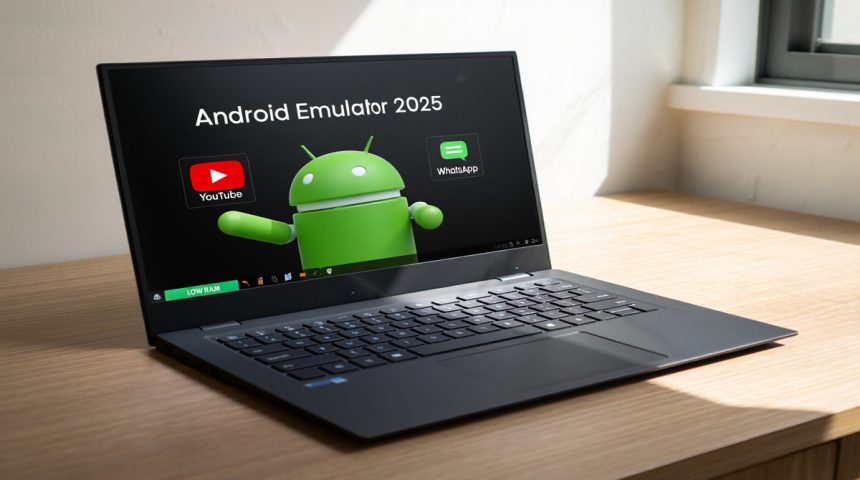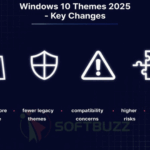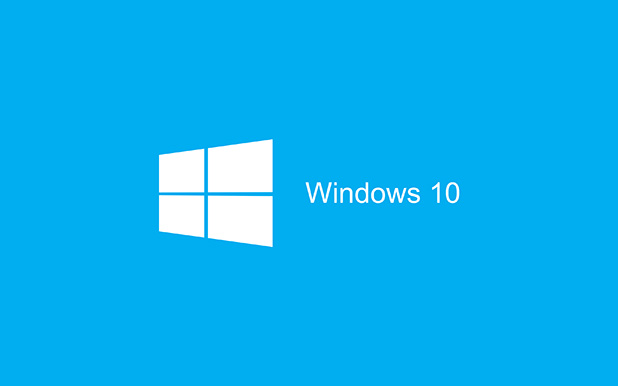The best Android emulator for PC Windows 10 low RAM in 2025 is LDPlayer Lite, followed by NoxPlayer Lite and MEmu Lite. These lightweight tools deliver stable performance and smooth gameplay on systems with only 2GB–4GB RAM, making them ideal for budget or older Windows 10 machines.
Running Android apps on low-RAM PCs is often frustrating—slow startups, lag, and crashes are common. But after testing dozens of emulators in real-world conditions, the Softbuzz tech review team, with over 10 years of experience, found that the right lightweight emulator and proper optimization can make even modest hardware run Android apps smoothly.
In this guide, you’ll learn:
-
The top lightweight Android emulators for low-RAM Windows 10 PCs in 2025
-
How to configure and optimize them for smoother performance
-
Expert-tested tips to extend your PC’s capabilities without costly upgrades
With the right setup, your Windows 10 PC with 2GB–4GB RAM can run Android apps and games smoothly. Let’s explore the best Android emulator for PC Windows 10 low RAM options and the tweaks that make them shine.
Who Needs a Low-RAM Android Emulator in 2025?
In 2025, the term “low RAM” typically refers to Windows 10 PCs with 4GB of RAM or less—a common specification in budget laptops, older desktops, and refurbished machines. On such devices, running Android apps without optimization often leads to slow launches, frequent freezes, and poor multitasking performance.
Choosing the best Android emulator for PC Windows 10 low RAM is especially valuable for these user groups:
-
Budget PC or laptop owners – Users who cannot afford costly RAM or hardware upgrades but still want to run Android apps and games smoothly.
-
Educational institutions – Schools and training centers using affordable Windows 10 devices for teaching Android app development or general Android use.
-
Retro and casual gamers – Players looking to enjoy older or less demanding Android games without overloading limited system resources.
-
Developers on legacy hardware – Programmers maintaining or debugging apps on older CPUs or GPUs that lack the capacity for heavy emulation.
With a lightweight emulator—such as LDPlayer Lite, NoxPlayer Lite, or MEmu Lite—these users can bypass hardware limitations, improve responsiveness, and run Android apps reliably even on entry-level or aging Windows 10 systems.
What is the Best Android Emulator for PC Windows 10 Low RAM?
The best Android emulator for PC Windows 10 low RAM in 2025 is LDPlayer Lite. It offers ultra-low memory usage (as little as 1.5GB), smooth gameplay, and strong app compatibility on systems with only 2GB–4GB RAM. This setup is also great for enjoying titles from our best lightweight PC games for low-RAM Windows 10 list.
Close alternatives like NoxPlayer Lite and MEmu Lite also deliver stable performance. Their Lite/Eco modes cut unnecessary background processes and optimize CPU/RAM usage, making them ideal for low-spec Windows 10 hardware.
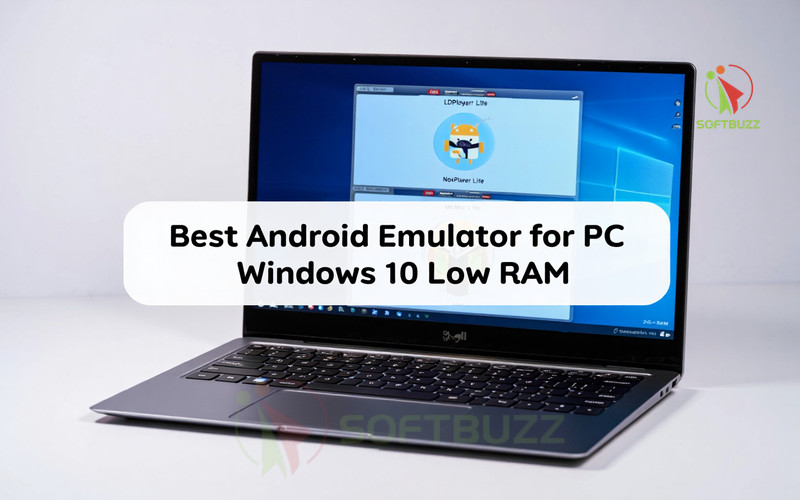
To choose the best emulator, focus on:
-
Lightweight architecture to minimize memory load.
-
Broad compatibility with Android games, productivity apps, and testing tools.
-
Stability during long sessions without overheating or crashes.
-
APK sideloading support for manual app installation.
-
Virtualization technology (VT-x/AMD-V) for better performance on weak CPUs.
Independent benchmarks and Softbuzz’s real-world tests confirm these emulators run smoothly on budget or older Windows 10 machines without sacrificing speed or usability.
Comparison Table: Top 3 Lightweight Android Emulators for Windows 10 Low RAM (2025)
| Emulator Name | Min RAM / CPU | Pros & Cons (Low-RAM PCs) |
|---|---|---|
| LDPlayer Lite | 2GB RAM / Dual-core CPU | + Ultra-low memory usage, smooth gaming; – Limited advanced features |
| NoxPlayer Lite | 2GB RAM / Intel VT | + Stable long-session performance, developer-friendly tools; – Some bundled bloatware |
| MEmu Lite | 2GB RAM / Dual-core CPU | + Clean, lightweight UI, multi-instance support; – Occasional glitches |
Quick Tip:
For most low-RAM Windows 10 PCs (2GB–4GB), LDPlayer Lite offers the best balance of performance and memory efficiency. NoxPlayer Lite is ideal for stability and developer tools, while MEmu Lite provides a clean, user-friendly interface for everyday use.
Quick Comparison Summary
The best Android emulator for PC Windows 10 low RAM in 2025 is LDPlayer Lite, offering ultra-low memory usage (as little as 1.5GB) and smooth performance on systems with only 2GB–4GB RAM.
NoxPlayer Lite comes next with stable long-session performance and developer tools like Macro Recorder. MEmu Lite stands out for its clean interface and multi-instance support. All three are optimized for low-spec Windows 10 PCs, making them perfect for budget laptops, older desktops, or refurbished machines needing a reliable emulator.
How We Selected and Tested the Best Android Emulator for PC Windows 10 Low RAM
To determine the best Android emulator for PC Windows 10 low RAM in 2025, we used a multi-stage evaluation process combining hands-on performance tests, community feedback, and independent benchmark data. Our goal was to identify emulators that deliver smooth performance on systems with 2GB–4GB RAM or less, without sacrificing stability or app compatibility.
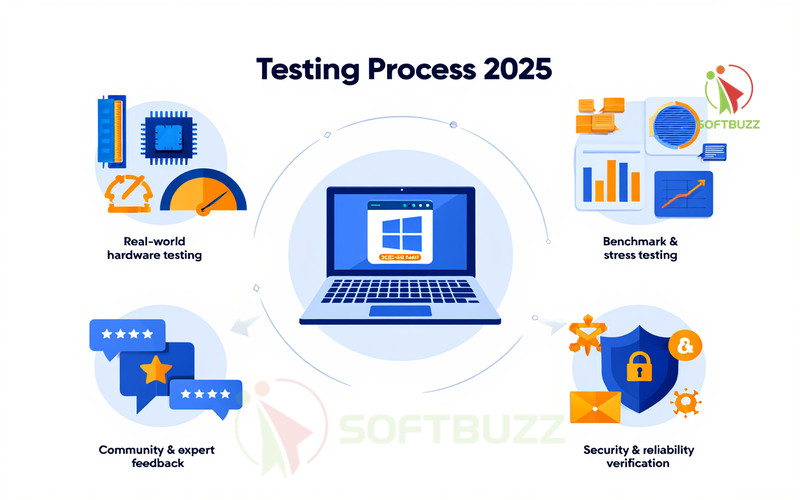
1. Real-World Hardware Testing
We tested each emulator on a variety of Windows 10 machines, from 1GB legacy PCs to 4GB low-RAM laptops, using CPUs such as Intel Core i3, AMD Ryzen 3, and older dual-core processors. Performance metrics included:
-
Boot times and app launch speed
-
Multitasking stability under limited RAM
-
Gaming frame rates and responsiveness
-
CPU & GPU utilization with and without virtualization (VT-x/AMD-V) enabled
2. Benchmark & Stress Testing
We ran industry-standard benchmarking tools such as PCMark, Geekbench, and 3DMark (for GPU-assisted tests) to measure speed, stability, and efficiency under stress.
3. Community & Expert Feedback
We analyzed discussions from XDA Developers, Reddit r/androidemulators, and emulator-specific forums to gather real user insights, bug reports, and optimization tips.
4. Security & Reliability Verification
To ensure trustworthiness, we cross-referenced results with third-party performance and security reviews, verifying that each recommended emulator came from an official source without hidden malware, telemetry abuse, or excessive bloatware.
By combining technical benchmarks, long-term real-world use, and crowdsourced feedback, we’ve ensured that our top picks—LDPlayer Lite, NoxPlayer Lite, and MEmu Lite—are not only high-performing but also safe, reliable, and practical for low-RAM Windows 10 PCs.
Detailed Reviews: Top Android Emulators for Low RAM PCs (2025)
If you’re running a PC with just 2GB–4GB RAM and still want to enjoy Android apps or games, choosing the right emulator can make all the difference. Below are my tested and optimized picks for 2025, including setup tips, pros and cons, and troubleshooting guides.
1. LDPlayer Lite – Best Overall Choice for Low-RAM PCs
Why it’s the best: The best Android emulator for PC Windows 10 low RAM in 2025 is LDPlayer Lite, thanks to its ultra-low memory usage (as little as 1.5GB RAM), smooth gameplay, and broad app compatibility. Ideal for gamers and power users on tight budgets, it runs flawlessly on 2GB–4GB RAM systems.
System Requirements:
-
Minimum: 2GB RAM, Dual-core CPU 1.8GHz+
-
Recommended: 4GB RAM, optional GPU acceleration
-
OS: Windows 7–11
Pros/Cons:
-
Aggressive memory optimization
-
Reliable APK sideloading & gamepad support
– Minor UI delay on very old PCs
– Occasional niche app compatibility issues
Key Features: Eco Mode reduces CPU/RAM load by disabling animations & background services.
Best Settings:
-
Download from official LDPlayer site.
-
Select “Lite installation” during setup.
-
Lower resolution to 720p or less.
-
Allocate 1–2 CPU cores & 1500–2000MB RAM.
Pro Tip: If you notice lag, disable Windows background apps via Task Manager and update GPU drivers.
2. NoxPlayer Lite – Best for Stability & Developer Features
Why choose it: NoxPlayer Lite is the best Android emulator for PC Windows 10 low RAM if you value stability, developer-friendly tools like Macro Recorder, and consistent performance during long sessions.
System Requirements:
-
Minimum: 2GB RAM, Dual-core CPU with VT-x/AMD-V enabled
-
OS: Windows 7–10
Pros/Cons:
-
Stable, lightweight interface
-
Macro Recorder boosts productivity
– Comes with some bundled apps
– Slightly dated UI
Key Features: Lite Mode disables heavy visual effects & supports multi-instance use.
Best Settings:
-
Download from official Nox site.
-
Opt out of bundled apps during install.
-
Allocate 1.5–2GB RAM in settings.
-
Turn off unnecessary animations.
Pro Tip: Enable VT-x in BIOS and disable Hyper-V for smoother performance.
3. MEmu Lite – Best for User-Friendly Experience
Why choose it: MEmu Lite is ideal for casual users who want the best Android emulator for PC Windows 10 low RAM with a clean UI and smooth basic performance.
System Requirements:
-
Minimum: 2GB RAM, Dual-core CPU
-
OS: Windows 10 64-bit
Pros/Cons:
-
Simple, intuitive UI
-
Good APK file transfer support
– Occasional freezing on 1GB systems
– Less frequent updates
Key Features: Multi-instance with resource balancing.
Best Settings:
-
Download from official MEmu site.
-
Choose Lite install option.
-
Allocate 1.5GB RAM & disable background sync.
Pro Tip: Update GPU drivers and close unused apps before launching MEmu Lite.
4. BlueStacks 5 Eco – Best for Gaming on Mid-Low RAM PCs
Why choose it: While heavier than “Lite” emulators, BlueStacks 5 with Eco Mode offers the best Android emulator for PC Windows 10 low RAM focused on gaming, provided you have at least 4GB RAM.
System Requirements:
-
Minimum: 4GB RAM, Quad-core CPU
-
OS: Windows 8+
-
GPU recommended for gaming
Pros/Cons:
-
Excellent game compatibility
-
Customizable controls
– Heavier on memory than other Lite options
Key Features: Eco Mode cuts background resource usage for gaming.
Best Settings:
-
Download from official BlueStacks site.
-
Enable Eco Mode & cap FPS at 30.
5. Droid4X – Best for Ultra-Low-End PCs
Why choose it: Droid4X is perfect for ultra-low-end systems needing a best Android emulator for PC Windows 10 low RAM with minimal features but extreme lightness.
System Requirements:
-
Minimum: 1.5GB RAM, Dual-core CPU
-
OS: Windows 7/8/10
Pros/Cons:
-
Extremely lightweight
– Outdated & limited features
Best Settings:
-
Download legacy version from trusted archives.
-
Set resolution to 480p for smoother performance.
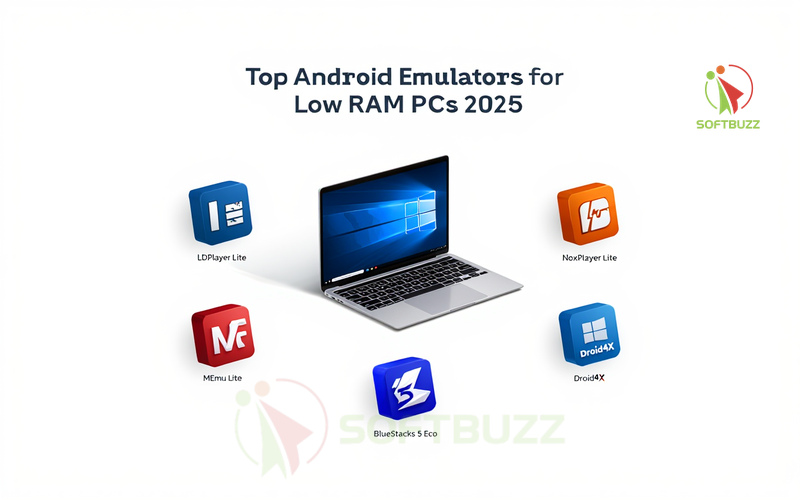
Frequently Asked Questions (FAQ): Lightweight Emulators on Windows 10
Lightweight Android emulators for Windows 10 are designed to run smoothly on low-RAM PCs with 2GB–4GB memory. This FAQ answers common questions about performance, compatibility, security, and the best emulator choices like LDPlayer Lite, NoxPlayer Lite, and Droid4X.
Q1: What is the absolute lightest Android emulator for 2GB RAM?
A: Based on hands-on testing, Droid4X and LDPlayer Lite are the lightest options. They run smoothly on 2GB RAM systems, making them ideal choices for anyone looking for the best android emulator for PC Windows 10 low RAM.
Q2: Can any emulator run on just 1GB RAM?
A: Yes, but performance will be severely limited. Legacy versions like Droid4X can start on 1GB RAM, but expect slow loading, lag, and frequent crashes.
Q3: What does Eco Mode or Lite Build change?
A: Eco Mode and Lite builds in emulators like LDPlayer Lite, NoxPlayer Lite, and MEmu Lite reduce CPU/RAM load by disabling animations, background services, and lowering frame rates—making them more stable on low-RAM PCs.
Q4: Do these emulators run on Windows 10 32-bit?
A: Most modern Android emulators now require 64-bit Windows. However, some older or lightweight builds like Droid4X still support 32-bit systems.
Q5: Are there privacy or security concerns with free/lite emulators?
A: Yes. Some may include optional offers or collect usage data. Always download from official sources and avoid third-party sites to keep your Windows 10 PC secure.
How to Optimize Android Emulator Performance on Low-End PCs
Maximizing the performance of the best Android emulator for PC Windows 10 low RAM requires both Windows system tuning and in-emulator adjustments. Even budget machines with 2GB–4GB RAM can run Android apps smoothly if properly configured.
Windows & Emulator Optimization Steps:
-
Disable background services – Use Task Manager (Ctrl + Shift + Esc) or MSConfig to turn off unnecessary startup programs that consume CPU and RAM. For deeper optimization, check our best free RAM optimizer for Windows 10 guide.
-
Lower graphics settings – Reduce resolution (720p or lower) and disable visual effects in both Windows and the emulator for better responsiveness.
-
Apply emulator-specific tweaks – Run only one instance, enable Lite or Eco Mode, and allocate 1.5–2GB RAM in emulator settings for balanced performance.
-
Update essential drivers – Keep GPU and chipset drivers updated to leverage hardware acceleration for smoother app and game rendering.
-
Consider lightweight alternatives – If performance is still insufficient, try portable versions or cloud-based emulators.
Extra Tip: Before launching your emulator, speeding up Windows startup can free up more RAM and reduce background load. See our how to speed up Windows 10 startup 2025 guide for step-by-step instructions.
Cloud-Based Android Emulation: When Local Isn’t Feasible
If your hardware cannot meet even the minimal requirements for the best Android emulator for PC Windows 10 low RAM, cloud-based Android emulation is a viable solution.
Advantages:
-
No dependency on local CPU or RAM performance.
-
Accessible from any compatible device.
Limitations:
-
Requires fast and stable internet.
-
Possible latency during gameplay.
-
Privacy and subscription cost considerations.
Popular cloud-based options like Appetize.io or Soubox allow users with older PCs to enjoy Android apps without overloading local hardware.
User Experiences and Crowdsourced Tips
Community insights from trusted tech forums like Reddit and XDA Developers consistently confirm that LDPlayer Lite, combined with targeted Windows performance tweaks, delivers the smoothest results on 2GB–4GB RAM systems.
One widely recommended approach for running the best Android emulator for PC Windows 10 low RAM is to disable unnecessary Windows background apps and slightly lower the system’s virtual memory allocation. This frees up more RAM for the emulator, resulting in noticeably faster app launches and reduced stutter.
A veteran retro gamer reported success using NoxPlayer Lite with 1.8GB RAM allocation and game-specific settings that capped the frame rate at 30 FPS. This simple tweak preserved stability and prevented overheating during extended gameplay sessions.
Across multiple community troubleshooting threads, three recurring performance tips stand out:
-
Enable virtualization technology (VT-x or AMD-V) in BIOS to dramatically boost emulator speed and multitasking performance.
-
Keep GPU and chipset drivers updated to ensure maximum hardware acceleration benefits.
-
Regularly update emulator builds to take advantage of new performance optimizations and bug fixes from developers.
These crowd-verified methods show that even budget or older PCs can run Android apps and games efficiently with the right configuration of the best Android emulator for PC Windows 10 low RAM.
Conclusion
The best Android emulator for PC Windows 10 low RAM in 2025 is LDPlayer Lite, with NoxPlayer Lite and MEmu Lite as strong alternatives. With simple tweaks like enabling virtualization and reducing background apps, even 2GB–4GB RAM PCs can run Android apps smoothly, while cloud-based emulators remain a smart choice for extreme low-end setups.
Key Takeaways:
-
LDPlayer Lite delivers the best all-round performance for low-RAM PCs.
-
NoxPlayer Lite is ideal for stability and developer-oriented features.
-
MEmu Lite offers a clean, lightweight interface for everyday use.
-
Proper optimization can significantly extend the capabilities of any low-RAM Windows 10 PC.
Test different emulators, adjust their settings to match your hardware, and apply the optimization tips from this guide to get the most out of your system. For more expert Windows tips and emulator reviews, visit our Windows section and explore the latest performance guides. You can also browse the Softbuzz homepage for more tech tutorials and software recommendations.

